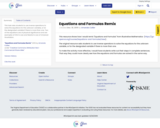
This resource will show how to teach your students to make their own "formula calculator" using Java programming, and it has handouts for your students or your own use. It is ideal for Grade 7 and Grade 8 Math.The video in this resource walks you through the steps to teach your students to program their "formula calculator" using Java programming after they have been taught about geometric formulas. They can then use their calculator to help them solve their math problems. It will reinforce critical thinking skills and create a deeper understanding of how the formulas work.Students can use any Java IDE or even an online IDE. The lesson can be customized based on your familiarity with Java and your students' computer skills.The handouts show how to use arithmetic operators in Java as well as some Math class methods that will be helpful. The attached program can be used as a starting point for their programs.
- Subject:
- Algorithms and Programming
- Computer Science
- Mathematics
- Measurement and Geometry
- Material Type:
- Activity/Lab
- Lesson Plan
- Author:
- Tara Williams
- Date Added:
- 07/30/2021
